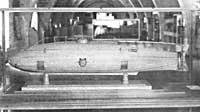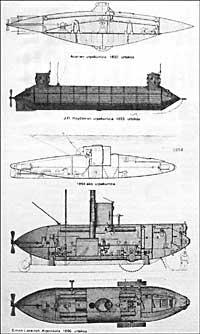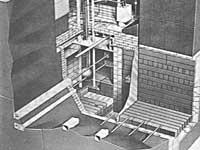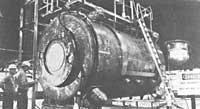Construction History X: Creating Diving
1987/04/01 Azkune Mendia, Iñaki - Elhuyar Fundazioa Iturria: Elhuyar aldizkaria

The first dive was built by David Bushell in North America. Since in 1771 the project was complete until it was launched in 1776, of course, it was spent very little time. It was a war of independence against the British, a violent agent.
The Bushnell dive had the form of two cokeels joined by the flat side. It was entirely made of wood, and thanks to a superior elliptical hole only one person could enter. The skylights were made of leather and closed completely with double screw that could be operated both from the inside and from the outside.
Diving had a unique egg-shaped room inside. The space between the gap and the outer wall was a space for water and ballast. A system of screws could introduce water and the boat could sink. To water the outside, there were pumps to be operated manually. The ballast (a piece of lead) could also be thrown if it wanted to emerge quickly.
To move the scuba diving forward it had a propeller that had to be operated manually. Diving could be conducted with a motto and carried the torpedo under the enemy ship.
The scuba driver was sitting in a fixed chair and had at his disposal all the control instruments for use in the dark.
For the renovation of the interior air it had two pipes. On the one hand there was clean air outside and on the other there was the interior. Thanks to a valve system, the water could not enter the interior.
The driver had lockers to see what was outside the boat. In addition, the depth prediction device was covered with phosphorescent substances and its light served to see the outside.
In that dive Sergeant Erza Lee tried to destroy in the summer of 1776 a British frigate from the New York area. Two years later, the same sergeant managed to stick the torpedo to the British ship Cerbero.
In 1797, Robert Fulton and David Bushnell met in France. Bushnell advised Fulton on underwater navigation and as a result a dive was made.
Fulton placed some conditions on the French government and although in 1798 he reached an agreement, in 1800 the first tests were carried out on the Seine River. Then it was tried in open sea.
Fulton's Nautilus scuba was fish-shaped, but the outer deck seemed like a hawk on the surface of the water. Thanks to special systems they lowered the mast and could dive in two minutes. Inside they could go three men with a suitable respiratory system. There were no tubes to introduce outside clean air. The air was stored in 200 atmospheres inside the dive in a adjustable cylinder.
Nautilus diving could not participate in the war. On the English Channel, British ships fled twice.
Fulton, therefore, in 1803 abandoned his Nautilus and dissolved it. In Europe, however, he had sown a seed to dive and improve. In Germany, Wilhelm Bauer had made his Brantaucher or underwater suppressor in 1850. The propeller had to be operated manually and the inner weight could be moved by pulleys. The scuba diving was made of steel.
In Catalonia, Narcis Monturiol from Cadaques analyzed the obstacles in coral fishing. It was then that the project of Ictineo, the cazo fish, ended. The ship was marine-shaped, seven meters long. Inside the cylindrical room there were six people, so diving was moving. It was launched at sea on 28 June 1859 in Barcelona. He spent two and a half hours on the water.
On October 2, 1864, Monturiol launched the second Ictineo. This second dive, seventeen meters long, had a height of two meters. The ship water with double steel hull covered the sea for eight hours at a depth of 30 meters. The ictineo had a perfumery of six horses to travel on the surface and another of two horses to climb the water. On the water surface the boiler was heated with coal. Underwater, with the heat of chemical reactions. By decomposing chlorates with metal powder, Monturiol obtained heat and respiratory oxygen by one way.
The absorption of carbon dioxide with lime allowed the cleaning of the respiratory air. Between both helmets, full of air or water, it managed to emerge or sink into the sea. To walk he used the influence of the double blade propeller.
The first real dive was built by Monturiol. But the government stopped collaborating and the new projects were suspended.
At that time, in 1863, a dive called Plongeur was built in France. With its 42.5 meters long and 6 meters wide, it was able to transport 453 tons. This steel vessel had compressed air propulsion. Despite the difficulties of balance and manoeuvre, Plongeur scuba diving allowed spectacular results.

Gai honi buruzko eduki gehiago
Elhuyarrek garatutako teknologia






